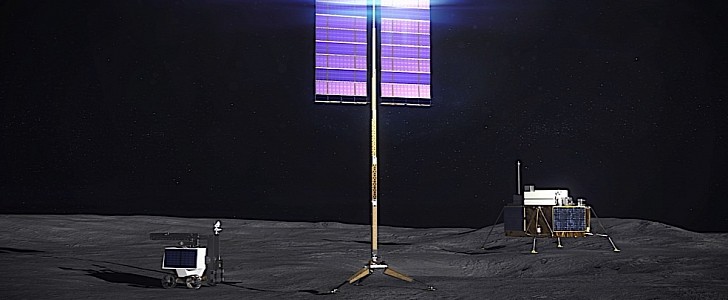The onset of the Artemis Moon exploration program next week will probably put humanity on a path to the colonization of the solar system. Although the main goal is to put human boots on the Moon once more, the program is just a stepping stone to the colonization of the place and expeditions to Mars.
For those greater goals to become a reality, a lot of side projects, from the creation of the Gateway lunar orbital station to finding ways to use the Moon’s water, have to go right. One of the most important such projects is the generation of power.
Since the Moon is basically a dead place, there’s no really feasible way to generate power other than to use the Sun. For that, solar panels are needed, and NASA is serious about getting the technology right.
Earlier this week, the space agency announced it has selected three companies in the Vertical Solar Array Technology (VSAT) project to “further advance work on deployable solar array systems.” The solutions are supposed to supply power to upcoming robotic and human missions to the Moon.
The three companies are Astrobotic Technology, Honeybee Robotics, and Lockheed Martin, and each received contracts worth between $6 million and $7 million for their work. Each of them is to “build prototypes and perform environmental testing, with the goal of deploying one of the systems near the Moon’s South Pole near the end of this decade.”
The main requirements for these systems include the ability to remain stable on sloped terrain, resistance to abrasive lunar dust, and reduced mass and stowed volume. The solar panels will not be spread on the ground or some flat surface, as they generally do here on Earth, but will be vertical and must be high enough to prevent loss of power due to the Moon’s terrain blocking the Sun.
Although we know the prototypes should be ready by the end of the decade, there’s no word yet on when they’ll be deployed on the Moon.
Since the Moon is basically a dead place, there’s no really feasible way to generate power other than to use the Sun. For that, solar panels are needed, and NASA is serious about getting the technology right.
Earlier this week, the space agency announced it has selected three companies in the Vertical Solar Array Technology (VSAT) project to “further advance work on deployable solar array systems.” The solutions are supposed to supply power to upcoming robotic and human missions to the Moon.
The three companies are Astrobotic Technology, Honeybee Robotics, and Lockheed Martin, and each received contracts worth between $6 million and $7 million for their work. Each of them is to “build prototypes and perform environmental testing, with the goal of deploying one of the systems near the Moon’s South Pole near the end of this decade.”
The main requirements for these systems include the ability to remain stable on sloped terrain, resistance to abrasive lunar dust, and reduced mass and stowed volume. The solar panels will not be spread on the ground or some flat surface, as they generally do here on Earth, but will be vertical and must be high enough to prevent loss of power due to the Moon’s terrain blocking the Sun.
Although we know the prototypes should be ready by the end of the decade, there’s no word yet on when they’ll be deployed on the Moon.




